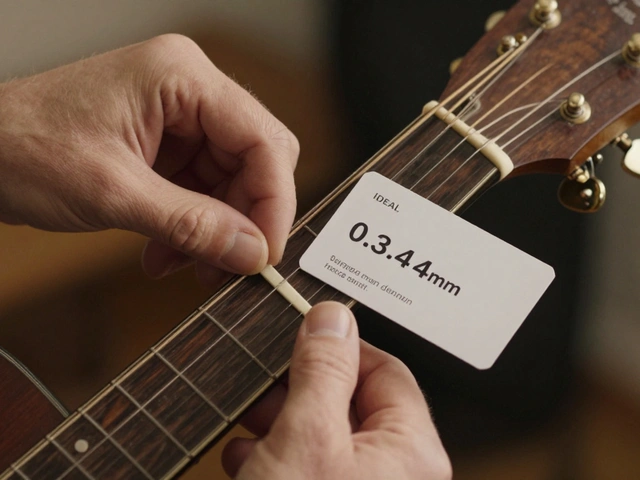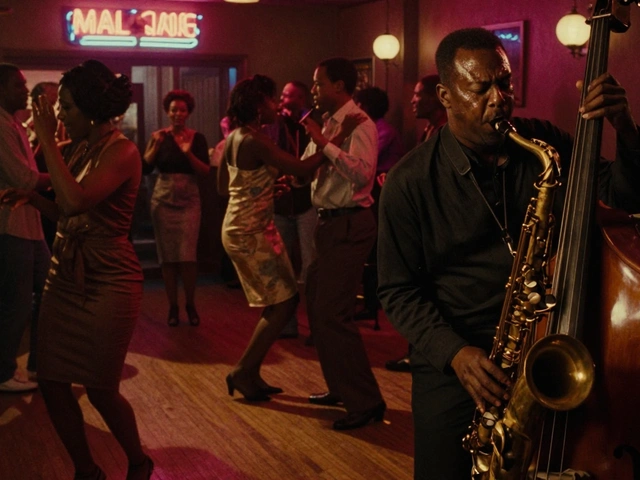Ever wondered what makes a rock song stick in your head? It's not just about loud guitars and thrashing drums. There's a whole structure at play that turns noise into memorable music. Let's break it down.
First up, the basics – most rock songs follow a pretty straightforward structure: verses, choruses, and maybe a bridge or two. The verse is where the story gets told. It sets the scene, introduces us to the characters, if you like. Then comes the chorus – the big payoff. It's memorable, catchy, and it's usually the bit you can't stop humming.
But don't overlook the guitar riffs. Those little repeating patterns can make or break a song. They create hooks that reel you in. Think of iconic riffs in classics by bands like Led Zeppelin or AC/DC. They're simple yet powerful and often the first thing you remember.
- The Basics of Rock Song Structure
- The Role of Guitar Riffs
- Lyrics That Resonate
- The Power of the Chorus
- Bridges: Connecting the Dots
- Dynamics and Energy in Rock Music
The Basics of Rock Song Structure
Getting into the nitty-gritty of a rock music song? It's all about how the pieces fit together. Most rock songs have a certain flow that fans find appealing, and that's thanks to a few key components.
Verse
The verse is like the storytelling aspect of a rock song. Each verse can unfold a narrative or simply build on a mood or theme. You usually hear more complex lyrics here, with more depth and description.
Chorus
Then comes the chorus, the part everyone can sing along to. It's often repeated several times throughout the song, with a catchy melody that gets stuck in your head. The chorus sums up the song’s main idea, often in a way that's easy to remember and identify with.
Bridge
Now, we can't forget the bridge. Not every rock song has one, but when it does, it serves to break things up a bit, providing contrast and keeping listeners engaged. It offers a departure from the usual verse-chorus pattern, helping reset the energy.
Intro and Outro
Most rock songs will also feature an intro and an outro. The intro sets the stage, often with a recognizable guitar riff or drum pattern. On the other hand, the outro ties things up nicely, potentially revisiting themes from the intro or giving a final twist to the song.
Here’s a quick look at how these components might line up in a typical rock song:
- Intro
- Verse 1
- Chorus
- Verse 2
- Chorus
- Bridge
- Chorus
- Outro
Understanding this basic structure can really elevate your appreciation of rock music. It’s like knowing the building blocks of what makes your favorite tracks come alive!
The Role of Guitar Riffs
Ask any lover of rock music what makes a song unforgettable, and they'll probably point to the guitar riffs. These riffs are the backbone of a track, often providing the catchy hook that draws you in.
Take, for instance, Deep Purple's "Smoke on the Water" or the opening riff of AC/DC's "Back in Black." These riffs are less about complexity and more about groove and feel. They're designed to be memorable but not necessarily intricate. Some of the best riffs are surprisingly simple—an interesting fact about rock music is that simplicity can often be more engaging.
How Riffs Fit into Song Structure
In many cases, a riff starts before the vocals even kick in, setting the tone and pulling the listener into the track's world. It's like an invitation that says, "Hey, come listen to this!" The riff often reappears throughout the song, making it a handy anchor that ties everything together.
Creating a Memorable Riff
For those interested in crafting their own, the key is repetition with a twist. Loop the riff enough for it to stick but throw in some variation to keep it fresh. Think about using different guitar effects like distortion or reverb to add texture and depth.
- Keep it simple.
- Find a groove that makes you tap your foot.
- Experiment with different sounds and effects.
- Don't be afraid to break the rules.
Even in modern rock, the riff remains a staple. It’s a bridge between eras and styles, maintaining relevancy by evolving with the times. Some bands even build entire albums around a single killer riff, proving its undeniable power in rock music.
So next time you're headbanging to your favorite rock music, take a moment to appreciate the guitar riffs. They're not just notes—they're the essence of the energy and vibe that make rock songs legendary.
Lyrics That Resonate
Lyrics are the heart and soul of any rock song. They connect with listeners on a deeper level, often capturing raw emotions or telling powerful stories. It's amazing how a few words can make us feel intense emotions or relate to experiences.
Emotional Impact
The best rock lyrics often tap into universal themes like love, rebellion, or personal struggle. Think about songs like Nirvana's "Smells Like Teen Spirit"—the lyrics capture a sense of teenage angst and rebellion that everyone can relate to. Another classic, "Bohemian Rhapsody" by Queen, takes listeners on a wild emotional ride, blending drama and introspection in just a few minutes.
Storytelling
Great lyrics often tell a story, sometimes even an epic one. Bruce Springsteen is a master of this, crafting entire worlds in songs like "Born to Run." His lyrics paint vivid pictures of life, love, and dreams in gritty detail. By connecting with these stories, we feel like we're living the journey with the characters.
Crafting Good Lyrics
If you're looking to write your own rock lyrics, start by picking a strong theme or emotion that resonates with you. Don't shy away from personal experiences—they can be a goldmine for authentic lyrics. Here are a few tips:
- Keep it simple. Sometimes less is more. A few powerful words can have a big impact.
- Be genuine. Write from the heart to connect with your audience.
- Experiment with rhyme but don't force it. Natural flow is key in rock music.
Use of Imagery
Imagery is a powerful tool in rock lyrics. By creating vivid pictures through words, songwriters can transport listeners into their world. Whether it's the "stairway to heaven" or riding a "mainstreet," these images stay with us long after the song ends.
Remember, the power of rock music lies in its ability to connect people through shared emotions and experiences. So next time you're listening to your favorite track, pay attention to the lyrics. They might just tell you more than you think.

The Power of the Chorus
When it comes to rock music, the chorus is where the magic happens. It's the part everyone sings along to and the moment where the song really explodes. The job of the chorus is simple – grab attention and drive the main message home.
The chorus stands out because of its repetition and catchy melody. Musicians often simplify the lyrics and melody here to make it more relatable and memorable. You can hear this in Nirvana's 'Smells Like Teen Spirit' or Queen's 'We Will Rock You'. It's this simplicity that makes a chorus so powerful.
Crafting A Rock Anthem
To create a killer chorus, rock bands focus on a few key elements:
- Memorable Hook: This could be a phrase or a riff that instantly grabs your attention. It's like the slogan of the song.
- Catchy Melody: Simple yet engaging, it makes you want to sing along. This is often the part that's stuck in your head long after the song ends.
- Energy and Emotion: The chorus often builds up from the verse, raising both the energy and emotional level.
Chorus in Numbers
Think choruses are just a fleeting part of a song? Check this out:
| Song | Chorus Length (in seconds) |
|---|---|
| Bohemian Rhapsody | 31 |
| Livin' on a Prayer | 38 |
| Sweet Child o' Mine | 45 |
These numbers show just how varied choruses can be even within top rock hits.
Understanding the song structure helps aspiring musicians and fans appreciate rock music even more. Take the time to revisit your favorite rock songs and see how their choruses follow these norms. Or better yet, start crafting your own!
Bridges: Connecting the Dots
If a rock music song is a journey, then the bridge is that unexpected detour that makes the trip unforgettable. Bridges are all about contrast. They give the song a break from the usual verse-chorus loop, bringing in new lyrics and a fresh melody.
A well-crafted bridge ramps up the emotional tension and paves the way for the final chorus. Take Queen's 'Bohemian Rhapsody' as an example. Its operatic bridge is a dramatic departure from the rest of the song, making it legendary in the world of rock music.
Why Use a Bridge?
Simple: variety and surprise. A bridge introduces new chords or a different tempo. It can throw listeners a curveball, waking them up if their attention has wandered. Bands like The Beatles often used bridges to take their songs to another level.
Crafting the Perfect Bridge
Got a song in the works? Here’s how to nail the bridge:
- Change the Chords: Take your usual chord progression and switch it up. Surprise your listeners with something fresh.
- Shift the Melody: Experiment with a new melodic line that contrasts with earlier parts of the song.
- Transition Smoothly: Make sure the bridge connects naturally to both the verse and the chorus. You don’t want it to stick out like a sore thumb.
Bridges are a pivotal part of song structure. When done right, they can be the defining moment of a track, providing depth and intensity that keeps people hitting replay.
Dynamics and Energy in Rock Music
When it comes to rock music, dynamics and energy are the secret sauce. They’re what make you want to jump up and down or air-guitar across the room. But what exactly are dynamics, and how do they translate into that energy we feel?
Dynamics refer to the variations in loudness and intensity throughout a song. It's not just about being loud all the time. In fact, some of the best rock music knows when to pull back, creating contrast and making those explosive moments hit even harder. Take Nirvana's 'Smells Like Teen Spirit' – it uses quiet verses and loud, punchy choruses to great effect.
Energy: Beyond Just Being Loud
Energy in rock isn't just a matter of cranking up the volume. It's about the tempo, the intensity of the performance, and the emotion conveyed. Bands like The Who and Foo Fighters master this by combining fast tempos with driving rhythms and powerful vocals.
Building Energy Through Song Structure
A typical rock song might start with a strong riff or beat to grab attention. Verses build the momentum, leading up to a chorus that releases all that built-up tension. Think of it like a rollercoaster ride – those build-ups followed by thrilling drops.
Interestingly, the pace of a song isn't everything. A band like Led Zeppelin could take a slower song and infuse it with energy through emotional intensity and musical complexity. 'Stairway to Heaven' is a great example – it starts slow and gradually builds to an epic climax.
Instrumental Contributions to Dynamics
Each instrument plays a part. Drummers, for instance, use fills and variations to keep things lively, while guitarists might switch between clean and distorted tones to add contrast. Bands also use harmonies and backing vocals to thicken the sound and elevate energy levels. Here's a quick look at how different instruments contribute:
- Guitars: Use distortion and effects for dramatic shifts.
- Drums: Variations in beat patterns to enhance intensity.
- Bass: Maintains the groove, often unnoticed but crucial.
- Vocals: Delivering emotional highs and lows.
In a nutshell, dynamics and energy are what give rock its punch. Next time you listen to a rock track, pay attention to how these elements play together. You'll appreciate the craft behind the chaos and might just enjoy it even more.






